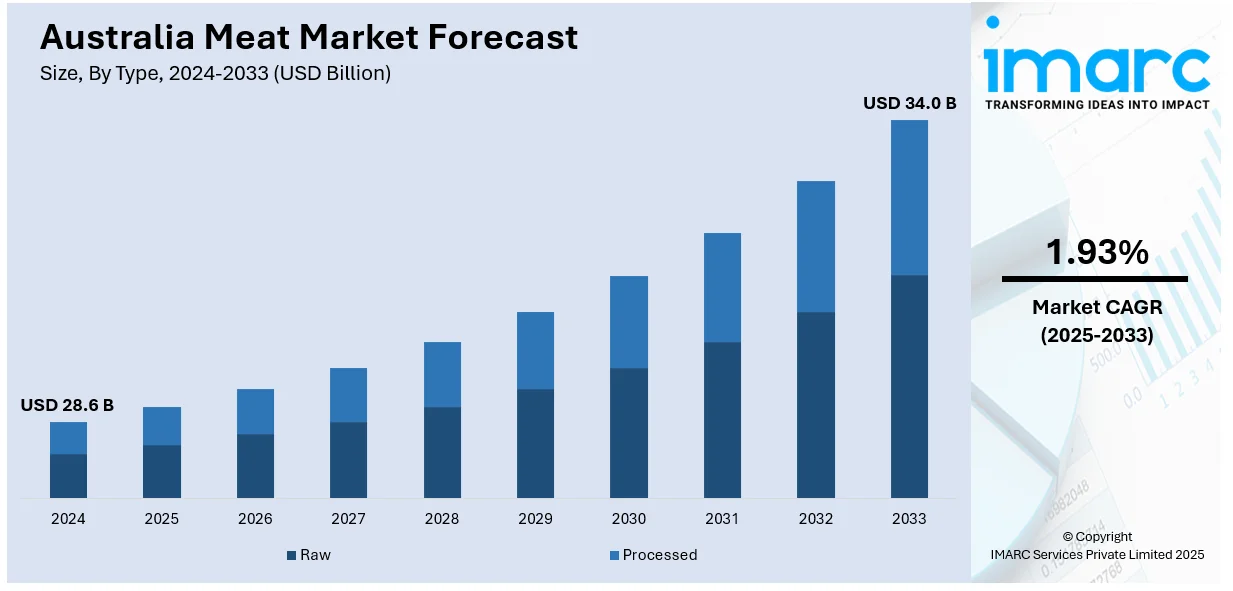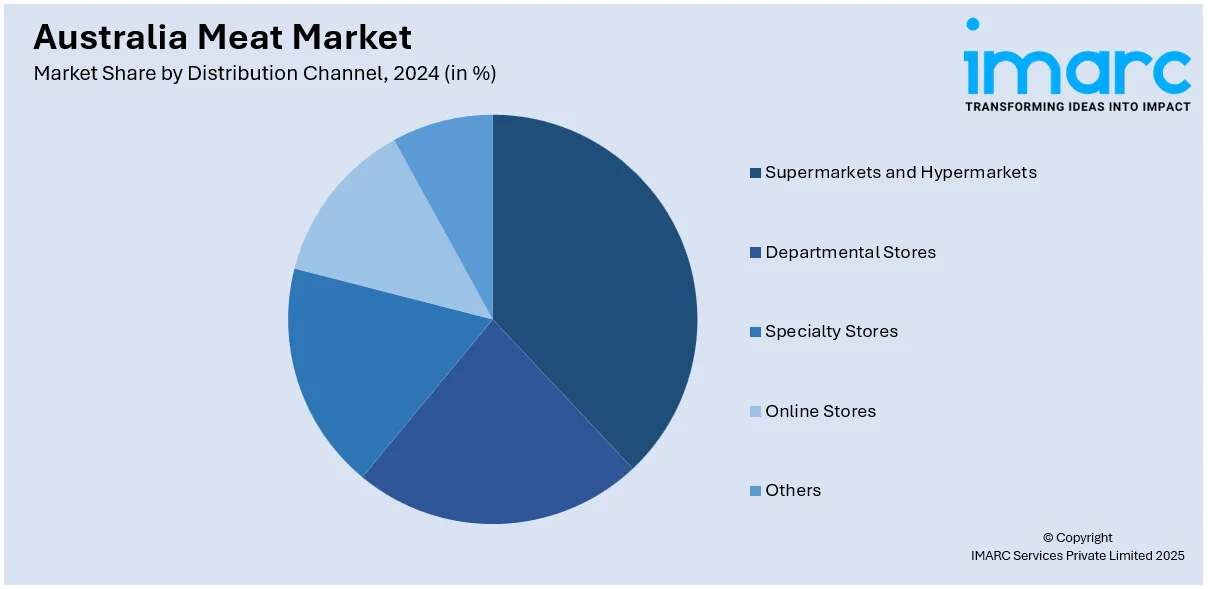
Australia Meat Market Size, Share, Trends and Forecast by Type, Product, Distribution Channel, and Region, 2025-2033
Australia Meat Market Size and Share:
The Australia meat market size reached USD 28.6 Billion in 2024. Looking forward, IMARC Group expects the market to reach USD 34.0 Billion by 2033, exhibiting a growth rate (CAGR) of 1.93% during 2025-2033. The market is driven by strong domestic demand, export growth, and sustainability initiatives, alongside rising protein consumption and free trade agreements that enhance global trade. Additionally, advanced meat processing technologies, increasing demand for premium and organic meat, climate conditions, feed costs, and animal welfare regulations shape market dynamics.
|
Report Attribute
|
Key Statistics
|
|---|---|
|
Base Year
|
2024 |
|
Forecast Years
|
2025-2033
|
|
Historical Years
|
2019-2024
|
| Market Size in 2024 | USD 28.6 Billion |
| Market Forecast in 2033 | USD 34.0 Billion |
| Market Growth Rate 2025-2033 | 1.93% |
Key Trends of Australia Meat Market:
Rise of Premium and Grass-Fed Meat Products
Australia's meat industry is experiencing a rising trend towards grass-fed and premium offerings, as consumers increasingly prioritize health, sustainability, and ethical sourcing. Grass-fed lamb and beef are especially in demand for their reduced fat profiles and increased omega-3 levels, making them a popular choice among health-conscious buyers. The trend is reinforced by greater transparency through more detailed product labeling, which highlights natural feeding practices and ethical production processes. Responding to demand, retailers have been increasing premium product ranges with a focus on certification and traceability to guarantee consumers about product excellence and responsible sourcing. Coupled with local demand, Australian meat is also picking up strength in international markets, where it is valued for its green and clean image. For instance, in February 2025, Jack's Creek, Australia's, introduced its premium Wagyu X range of beef into the UK via Ocado, including high-marbling Wagyu–Black Angus crossbreed cuts, following a 120% rise in interest for Wagyu beef. Further, the growth of the premium segment in international and domestic markets further enhances Australia's status as a leading exporter of high-quality, ethically grown meat, cementing its position as the world's leading exporter of meat.

To get more information on this market, Request Sample
Growth in Plant-Based and Hybrid Meat Alternatives
The Australia meat market is experiencing a gradual boost in plant-based and hybrid meat alternatives. Demand for products that minimize dependency on conventional animal protein is being driven by consumer interest in healthier living, sustainability, and ethical food production. For example, in September 2024, Australian brand vEEF introduced a carbon-neutral range of plant-based meats—including sausages and mince—at price parity to animal meat, providing sustainable, nutrient-dense options now rolling out nationally across Woolworths. Moreover, hybrid products, which blend meat with plant-based components, are becoming increasingly popular among consumers looking to cut back on meat without completely abandoning it. These offerings are attractive to flexitarians, a burgeoning segment in Australia. Grocers are growing their shelf space for these substitutes, frequently locating them next to conventional meat in an effort to induce trial. Innovation in products is centered on taste, texture, and nutrition to address changing expectations. Institutions, such as schools and care homes, are incorporating such choices onto their menus as well. Replacement is not what the shift is about, but diversification, giving consumers more options on how they satisfy their dietary and environmental objectives. The trend is likely to intensify as food tech continues to progress and acceptance expands.
Increased Demand for Export-Ready and Traceable Meat
Australia meat market is experiencing greater emphasis on export-ready, traceable product to address escalating global demands around food safety, origin, and quality. Sophisticated traceability technology now tracks livestock from paddock to packaging, with end-to-end visibility. This innovation enhances market access and increases confidence in international buyers, especially in Asia and the Middle East where food certification and safety are paramount. Governments and industry associations are working together on online platforms that ease export paperwork and logistics. Producers are conforming to international health, safety, and animal welfare standards to preserve and increase their access to overseas markets. On the consumer front, QR-coded packaging is providing enhanced product transparency, enabling end-consumers to check provenance and production processes. As global markets increasingly focus on traceability and quality control, the capacity of Australia to meet these areas continues to uphold its image as a sound provider of high-quality meat products.
Growth Drivers of Australia Meat Market:
Strong Agricultural Heritage and Export Capability
A strong foundation for reliable production is provided by Australia's long-standing agricultural heritage, which supports the country's meat market. Large-scale production of premium beef, lamb, and other meats is made possible by the nation's vast landmass, varied climates, and well-established livestock management techniques. Over many generations, Australian farmers have refined their grazing and breeding methods, making the country a reliable source of meat for both domestic and foreign markets. Furthermore, Australia has a competitive advantage in meat export due to its proximity to Asia-Pacific markets and its reputation for strict food safety regulations. The growth of the Australian meat market is continuously fueled by the blend of traditional farming knowledge with the ease of international trade.
Evolving Consumer Preferences and Health Awareness
The Australia meat market demand is being impacted by shifting consumer lifestyles as well as increased nutritional and health consciousness. Lean cuts and minimally processed meats that fit their dietary objectives are becoming more and more important to many consumers. As people look for quality and transparency in their food choices, grass-fed, hormone-free, and organic meat options have grown in popularity. Furthermore, consumers are becoming more interested in meat that comes from ethical sources, with concerns about traceability, environmental sustainability, and animal welfare. These values are a major market driver, as change in consumer preferences pushes producers to innovate and provide meat products that satisfy growing consumer expectations regarding ethical and health standards.
Technological Integration and Sustainable Practices
According to Australia meat market analysis, Australia's meat industry is influenced by technological developments in farming and meat processing. Technology is being used to increase productivity, guarantee quality control, and cut waste in a variety of applications, including cold chain logistics, automated meat processing, and precision farming. In addition, environmental sustainability has emerged as a major issue, leading the sector to embrace more environmentally friendly procedures. Efforts include incorporating renewable energy into operations, enhancing land management, and lowering emissions through improved feed systems. These developments strengthen technology and sustainability as key forces behind the market's ongoing development while also bolstering the long-term viability and international competitiveness of Australian meat products.
Australia Meat Market Segmentation:
IMARC Group provides an analysis of the key trends in each segment of the market, along with forecasts at the country level for 2025-2033. Our report has categorized the market based on type, product, and distribution channel.
Type Insights:
- Raw
- Processed
The report has provided a detailed breakup and analysis of the market based on the type. This includes raw and processed.
Product Insights:
- Chicken
- Beef
- Pork
- Mutton
- Others
A detailed breakup and analysis of the market based on the product have also been provided in the report. This includes chicken, beef, pork, mutton and others.
Distribution Channel Insights:

- Supermarkets and Hypermarkets
- Departmental Stores
- Specialty Stores
- Online Stores
- Others
The report has provided a detailed breakup and analysis of the market based on the distribution channel. This includes supermarkets and hypermarkets, departmental stores, specialty stores, online stores and others.
Regional Insights:
- Australia Capital Territory & New South Wales
- Victoria & Tasmania
- Queensland
- Northern Territory & Southern Australia
- Western Australia
The report has also provided a comprehensive analysis of all the major regional markets, which include Australia Capital Territory & New South Wales, Victoria & Tasmania, Queensland, Northern Territory & Southern Australia, and Western Australia.
Competitive Landscape:
The market research report has also provided a comprehensive analysis of the competitive landscape. Competitive analysis such as market structure, key player positioning, top winning strategies, competitive dashboard, and company evaluation quadrant has been covered in the report. Also, detailed profiles of all major companies have been provided.
Australia Meat Market News:
- In April 2024, Australian company Vow introduced the country's first cultured meat product, Quailia, a quail cell-based parfait approved by Singapore's food regulator. Priced under the Forged brand, it aims high-end restaurants, framing cultured meat as a new, luxury food experience separate from traditional animal protein.
Australia Meat Market Report Coverage:
| Report Features | Details |
|---|---|
| Base Year of the Analysis | 2024 |
| Historical Period | 2019-2024 |
| Forecast Period | 2025-2033 |
| Units | Billion USD |
| Scope of the Report | Exploration of Historical Trends and Market Outlook, Industry Catalysts and Challenges, Segment-Wise Historical and Future Market Assessment:
|
| Types Covered | Raw, Processed |
| Products Covered | Chicken, Beef, Pork, Mutton, Others |
| Distribution Channels Covered | Supermarkets and Hypermarkets, Departmental Stores, Specialty Stores, Online Stores, Others |
| Regions Covered | Australia Capital Territory & New South Wales, Victoria & Tasmania, Queensland, Northern Territory & Southern Australia, Western Australia |
| Customization Scope | 10% Free Customization |
| Post-Sale Analyst Support | 10-12 Weeks |
| Delivery Format | PDF and Excel through Email (We can also provide the editable version of the report in PPT/Word format on special request) |
Key Benefits for Stakeholders:
- IMARC’s industry report offers a comprehensive quantitative analysis of various market segments, historical and current market trends, market forecasts, and dynamics of the Australia meat market from 2019-2033.
- The research report provides the latest information on the market drivers, challenges, and opportunities in the Australia meat market.
- Porter's five forces analysis assist stakeholders in assessing the impact of new entrants, competitive rivalry, supplier power, buyer power, and the threat of substitution. It helps stakeholders to analyze the level of competition within the Australia meat industry and its attractiveness.
- Competitive landscape allows stakeholders to understand their competitive environment and provides an insight into the current positions of key players in the market.
Key Questions Answered in This Report
The Australia meat market was valued at USD 28.6 Billion in 2024.
The Australia meat market is projected to exhibit a CAGR of 1.93% during 2025-2033.
The Australia meat market is expected to reach a value of USD 34.0 Billion by 2033.
The Australia meat market is changing with a move toward premium and grass-fed meat as a result of consumer demand for goods sourced ethically and with consideration for their health. Concerns about sustainability are also reflected in the rise of plant-based and hybrid meat substitutes. Traceability technologies are also improving food safety and export preparedness.
Australia’s meat market is driven by its sophisticated livestock management, solid agricultural base, and growing demand worldwide. The industry is further shaped by consumer preferences for lean, premium meat that is sourced ethically. Efficiency is further enhanced by technological advancements and sustainability programs, which guarantee sustained competitiveness and expansion in both domestic and foreign markets.
Need more help?
- Speak to our experienced analysts for insights on the current market scenarios.
- Include additional segments and countries to customize the report as per your requirement.
- Gain an unparalleled competitive advantage in your domain by understanding how to utilize the report and positively impacting your operations and revenue.
- For further assistance, please connect with our analysts.
 Request Customization
Request Customization
 Speak to an Analyst
Speak to an Analyst
 Request Brochure
Request Brochure
 Inquire Before Buying
Inquire Before Buying




.webp)




.webp)












